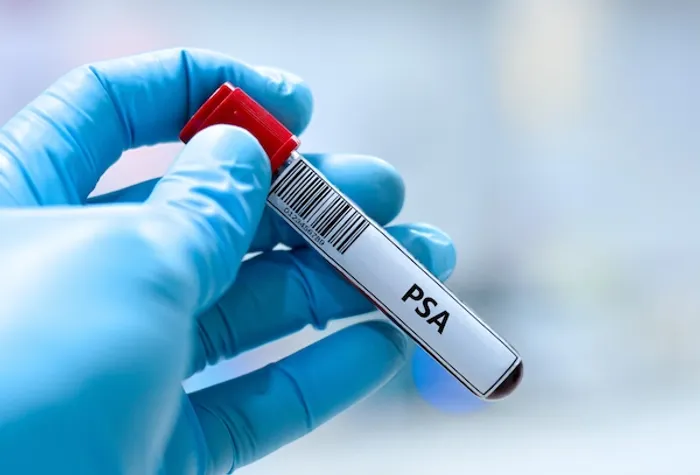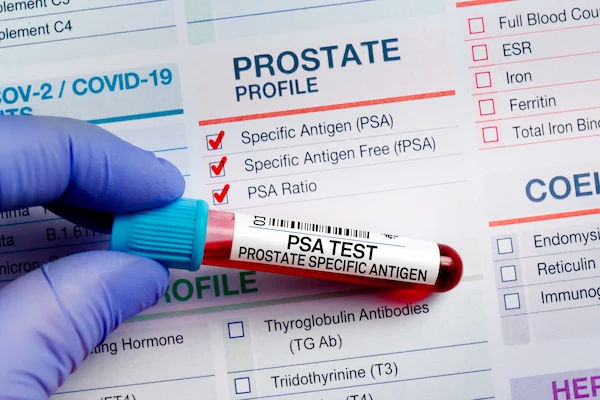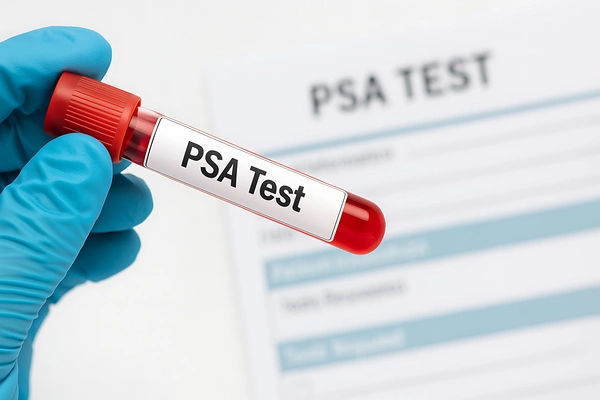Understanding Your PSA Test: A Guide to Normal Range and Results
Know about the PSA test, why it's done, the role of psa, step-by-step procedure, what to do with the result, normal range and screening guidelines.

Written by Dr. M L Ezhilarasan
Reviewed by Dr. Rohinipriyanka Pondugula MBBS
Last updated on 22nd Sep, 2025

Introduction
Receiving your PSA test results can be a moment of anxiety, filled with a single pressing question: Is my number normal? The Prostate-Specific Antigen (PSA) test is a common blood test primarily used for prostate cancer screening, but interpreting its results is far from black and white. While a standard PSA test normal range exists, it's merely a starting point for a deeper conversation with your doctor. This comprehensive guide will demystify the PSA test, explain the nuances of the normal range, and explore the many factors that can influence your levels.
What is a PSA Test and Why is it Done?
A PSA test measures the amount of prostate-specific antigen, a protein produced by both cancerous and non-cancerous tissue in the prostate gland, in your blood. It's a simple blood draw, but its purpose is multifaceted. While often synonymous with cancer screening, its uses are broader.
The Role of Prostate-Specific Antigen
PSA’s primary biological function is to help liquefy semen. Normally, only small amounts leak into the bloodstream. However, when the prostate is disturbed, whether by enlargement, inflammation, infection, or cancer, more PSA can seep into the blood, causing levels to rise. It's crucial to understand that PSA is not a cancer-specific marker; it's a prostate-specific one.
Consult a General practitioner for Personalised Advice
Primary Uses of the PSA Blood Test
The test serves three main purposes:
1. Screening: To check for early signs of prostate cancer in men with no symptoms.
2. Monitoring: For men diagnosed with prostate cancer, it tracks the effectiveness of treatment and checks for recurrence.
3. Diagnosis: As part of the diagnostic process for men experiencing symptoms of prostate issues, such as difficulty urination.
Naturally, if you're experiencing any urinary symptoms, it's important to consult a doctor for a proper evaluation. You can consult a urologist online with Apollo24|7 to discuss your symptoms and whether a PSA test is right for you.
What is the Normal PSA Range?
This is the core of the question, and the answer is more nuanced than a single number.
The Traditional Benchmark: 0 to 4.0 ng/mL
Historically, a PSA level of 4.0 nanograms per millilitre (ng/mL) of blood has been used as the cutoff for a normal PSA test range. Levels below this were generally considered normal, while levels above suggested a need for further investigation, such as a biopsy.
Why Age-Specific PSA Ranges Matter
Modern medicine recognises that the prostate naturally enlarges with age (a condition called benign prostatic hyperplasia or BPH), which can naturally raise PSA levels. Therefore, a "normal" level for a 75-year-old man is different from that of a 45-year-old. Using age-adjusted ranges helps prevent unnecessary anxiety and procedures in older men while catching potentially significant rises in younger men.
Sample Age-Adjusted PSA Levels Chart
It includes:
- Age 40-49: Normal range is typically 0-2.5 ng/mL
- Age 50-59: Normal range is typically 0-3.5 ng/mL
- Age 60-69: Normal range is typically 0-4.5 ng/mL
- Age 70-79: Normal range is typically 0-6.5 ng/mL
The Grey Area: PSA Levels Between 4 and 10
This range is often called the "diagnostic gray zone." A level in this range does not automatically mean cancer. In fact, only about 25% of biopsies in this range find cancer; the rest are due to BPH or prostatitis. This is where advanced PSA metrics become critical for decision-making.
Understanding High PSA Levels (Above 10 ng/mL)
A PSA level above 10 ng/mL is associated with a higher probability of prostate cancer (over 50%). While this certainly warrants prompt and thorough investigation by a urologist, it is still not a definitive diagnosis, as BPH can sometimes cause levels to rise this high.
It's Not Just a Number: Key Factors That Influence PSA Levels
Your PSA level is not just about cancer. Numerous factors can cause fluctuations.
Common Medical Conditions That Elevate PSA
- Benign Prostatic Hyperplasia (BPH): The non-cancerous enlargement of the prostate, very common in older men, is a leading cause of elevated PSA.
- Prostatitis: This infection or inflammation of the prostate gland can significantly spike PSA levels, which usually return to normal after treatment with antibiotics.
Medications and Procedures That Affect PSA
Certain medications for BPH and hair loss (e.g., finasteride, dutasteride) can artificially lower PSA levels by about 50%. Your doctor needs to know if you are taking these to interpret your results correctly.
Recent procedures like a cystoscopy, prostate biopsy, or even a long bike ride can irritate the prostate and temporarily raise PSA.
Lifestyle and Activity Considerations Before a Test
To avoid a falsely elevated reading, doctors often recommend:
- Avoiding ejaculation for 48 hours before the test.
- Do not take the test if you have a current urinary tract infection.
- Postponing the test for several weeks after a prostate biopsy or cystoscopy.
Beyond the Baseline: Advanced PSA Metrics
When the total PSA level is ambiguous, doctors look at these more refined measures.
PSA Velocity (The Rate of Change)
This measures how quickly your PSA level rises over time. A rapid increase (e.g., more than 0.75 ng/mL per year) can be a more concerning sign than a single slightly high value that remains stable, even if it's above 4.0.
PSA Density (Accounting for Prostate Size)
A larger prostate produces more PSA. PSA density calculates the PSA level relative to the volume of the prostate (measured via ultrasound/MRI). A high PSA level might be less concerning if the patient has a very large prostate, as the "density" is low.
Free PSA vs. Total PSA Ratio
PSA circulates in the blood in two forms: bound to proteins or free. The percentage of free PSA is lower in men with prostate cancer compared to those with BPH. Therefore, a low free PSA percentage (e.g., below 10%) when the total PSA is elevated suggests a higher risk of cancer and may indicate the need for a biopsy.
What to Do After Getting Your PSA Results
Interpreting Your PSA Level with a Doctor
Do not interpret your PSA results in isolation. The number is a piece of a puzzle that includes your age, family history, race, overall health, and any symptoms. A urologist is the best specialist to put this puzzle together. If your PSA level is elevated or you're unsure about the results, consulting a doctor online with Apollo24|7 can provide initial guidance and help you plan the next steps.
Possible Next Steps and Diagnostic Tools
An elevated PSA does not mean you need an immediate biopsy. Next steps may include:
- Repeat PSA testing: To confirm the level.
- Free PSA test: To calculate the ratio.
- Imaging: An MRI of the prostate to look for suspicious areas.
- Biopsy: If warranted, a biopsy is the only way to definitively diagnose cancer.
The PSA Test Debate: Screening Guidelines and Informed Decisions
It includes:
- Weighing the Benefits and Risks of Screening
- Major health organisations agree that the decision to get screened should be an individual one made after a discussion with your doctor. The benefit is the potential for early detection of aggressive cancer. The risks include false positives leading to unnecessary biopsies (which have their own risks) and the overdiagnosis of slow-growing cancers that would never have caused harm, leading to overtreatment. This discussion is crucial for men aged 55-69..
Conclusion
Understanding your PSA test normal range is the first step toward taking an active role in your prostate health. Remember, the number on the lab report is a signal, not a sentence. It's a valuable tool that, when interpreted wisely with the guidance of a skilled doctor, can provide important insights. The journey from screening to diagnosis is nuanced, relying on a combination of factors beyond a single metric. If you have concerns about your prostate health or need to get a PSA test done, remember that Apollo24|7 offers convenient home collection for lab tests, making it easier to take that first step. Your health is a partnership, and understanding tests like the PSA is a powerful part of that collaboration.
Consult a General practitioner for Personalised Advice
Consult a General practitioner for Personalised Advice

Dr. Syed Ismail Ali
General Practitioner
7 Years • MBBS
Hyderabad
Apollo 24|7 Clinic, Hyderabad

Dr. M L Ezhilarasan
General Practitioner
6 Years • MBBS
Visakhapatnam
Apollo 24|7 Clinic - Andhra Pradesh, Visakhapatnam

Dr D M Karthik
General Practitioner
4 Years • MBBS, Fellowship in Diabetes Mellitus, Advance certificate in Diabetes Mellitus, Derma Nutrition Certification
Visakhapatnam
Apollo 24|7 Clinic - Andhra Pradesh, Visakhapatnam

Dr. Pankaj Tripathi
General Practitioner
20 Years • MBBS, MD Pathology
Lucknow
Best Diabetologist Clinic, Lucknow

Dr. Ritesh Motghare
General Practitioner
18 Years • MBBS PGCDM
Nagpur
HEALTH CENTRE VNIT NAGPUR, Nagpur
Consult a General practitioner for Personalised Advice

Dr. Syed Ismail Ali
General Practitioner
7 Years • MBBS
Hyderabad
Apollo 24|7 Clinic, Hyderabad

Dr. M L Ezhilarasan
General Practitioner
6 Years • MBBS
Visakhapatnam
Apollo 24|7 Clinic - Andhra Pradesh, Visakhapatnam

Dr D M Karthik
General Practitioner
4 Years • MBBS, Fellowship in Diabetes Mellitus, Advance certificate in Diabetes Mellitus, Derma Nutrition Certification
Visakhapatnam
Apollo 24|7 Clinic - Andhra Pradesh, Visakhapatnam

Dr. Pankaj Tripathi
General Practitioner
20 Years • MBBS, MD Pathology
Lucknow
Best Diabetologist Clinic, Lucknow

Dr. Ritesh Motghare
General Practitioner
18 Years • MBBS PGCDM
Nagpur
HEALTH CENTRE VNIT NAGPUR, Nagpur
Frequently Asked Questions
What is a dangerously high PSA level?
There's no specific 'dangerous' level, as PSA is not a direct measure of danger. However, levels above 10 ng/mL are associated with a significantly higher risk of prostate cancer and require urgent urological consultation. Levels above 50-100 ng/mL often indicate advanced disease.
Can a PSA level go down naturally?
Yes, if an elevated PSA is caused by a temporary condition like prostatitis, it will go down after the infection is treated with antibiotics. Some lifestyle changes, like a healthier diet and regular exercise, may also contribute to modest reductions, but you should always consult a doctor for high PSA levels.
What is a good PSA level for a 70-year-old man?
For a 70-year-old, a PSA level below 6.5 ng/mL is often considered within the normal age-adjusted range. However, a doctor would also check if the level is stable or rising rapidly from previous tests.
How can I lower my PSA before a test?
You should not try to artificially lower your PSA before a test, as this can mask a potential problem. Instead, follow your doctor's pre-test instructions (avoid ejaculation, bike riding, etc.) to ensure an accurate reading that reflects your true prostate health.
Is a PSA of 5.0 ng/mL considered high?
It depends. For a 50-year-old man, a PSA of 5.0 is above the age-specific range (0-3.5) and would be investigated. For a 65-year-old man, it is within the common age-adjusted range (0-4.5/6.5) and might be considered normal if it's stable and he has no other risk factors. Context is everything.



